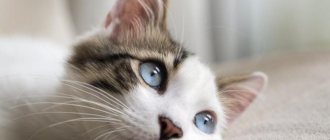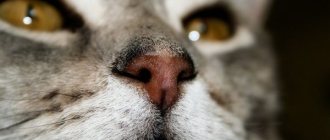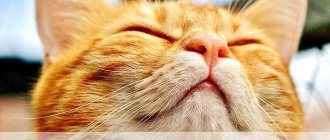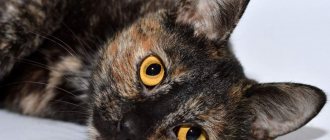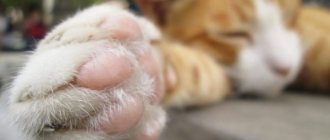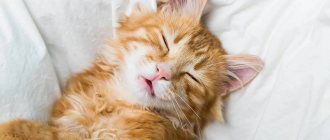8075Pavel
4
A phenomenon that is perceived from people with hostility, misunderstanding, and sometimes with concern for their health, is perceived with affection from cute pets. When a cat farts, we even want to laugh. But why does a cat fart? Perhaps there is no reason to laugh, but is this a warning to us, the owners, that the animal is not in good health? Or is the problem not so serious that you need to worry about it? Let's look at the reasons why a cat farts. And we will understand how to act and what the cat needs.
Causes of flatulence in cats
When “farting”, air and gases, which are formed under the influence of microorganisms, escape from the intestines through the animal’s anus.
The accumulation of large amounts of gases is accompanied by:
- rumbling in the intestines (sounds of peristalsis);
- manifestation of hiccups (when intestinal loops overcrowded with air irritate certain parts of the vagus nerve);
- exiting through the anus in small, imperceptible doses;
- explosive release of a large accumulation (what is called a “fart”).
Important! The release of gas from the intestines is completely normal. But. This process is the norm if others do not notice it. Up to 1000 cm3 of methane gas is formed in the intestines per day. It all comes out of the intestines in small parts and the owner’s nose cannot smell it.
The causes of gas formation may be:
- aerophagia. Along with the food, the animal swallows some of the air - this is the norm. Under the influence of various factors (stress, fear, rapid swallowing of food, eating large pieces), the cat swallows an excessive amount, and it accumulates in the intestinal tract. Excess air can be swallowed by an animal due to blockage of the nasal passages (rhinitis) as well as diseases of the oral cavity, teeth, esophagus, stomach;
- improper feeding diet;
- feeding with low-quality feed;
- feeding with food that causes fermentation processes in the intestines;
- infrequent feeding with a long time interval;
- allergic reactions to feeding certain types of food;
- pathologies of the gastrointestinal system of an inflammatory nature;
- oncological pathologies that cause blockages in certain areas of the intestine;
- the presence of sexually mature parasites in the intestinal lumen.
Diseases accompanied by the release of gases
Excessive formation and release of gases usually occurs with pathologies in the gastrointestinal tract, both in the upper and lower sections. It could be:
- stomatitis (inflammation of the oral mucosa);
- gingivitis (gum inflammation);
- esophagitis (inflammation of the esophagus);
- gastritis (inflammation of the stomach);
- enteritis (inflammation of the small intestine);
- colitis (inflammation of the large intestine);
- diseases of a tumor nature in all parts of the gastrointestinal tract.
If we consider helminthic infestation, then flatulence is observed in diseases such as:
- opisthorchiasis;
- diphylobothriasis;
- toxocariasis;
- Dipylidiasis.
There are a number of infectious diseases of a bacterial and viral nature that cause pathology in the digestive system and flatulence as one of the symptoms. Such diseases include:
- salmonellosis;
- colibacillosis;
- viral enteritis.
It should be noted that flatulence does not necessarily accompany these diseases. They can manifest themselves without it, in fact, just like vice versa. To establish a diagnosis, a comprehensive clinical and laboratory examination of the animal is necessary.
Could cat fart be a sign of serious health problems?
If your cat experiences gas or the gas is caused by something she ate, there is nothing to worry about. The gas will flow on its own.
However, sometimes gas in cats is a symptom of something more serious.
You should call your veterinarian if your cat has persistent symptoms such as vomiting, bloating, bloody stool, foul-smelling gas, or if it refuses to eat or drink.
Some serious gastrointestinal problems in cats include:
- Inflammatory bowel disease
- Ulcers
- Gastrointestinal obstruction
- Worms or other intestinal parasites
- Cancer
Your veterinarian will examine your cat and ask about its diet and health history. They may ask for a stool sample or order blood tests or x-rays to find out what is causing your cat's gas and other symptoms.
Additional symptoms and what they mean
If flatulence is minor, then additional signs may be invisible or absent. But sometimes flatulence is accompanied by symptoms that can diagnose a serious illness.
Strong unpleasant odor
Normally, methane is produced in the intestines. When hydrogen sulfide and other components are added to this gas, the methane is diluted with aromatic compounds and the mixture acquires a stench.
Gas is formed as a product of the vital activity of microorganisms. If the “wrong microbe” multiplies in the intestines, then the processes become uncontrollable. A rapid increase in the number of opportunistic microorganisms or the entry and proliferation of pathogenic microorganisms leads to unpleasant odors.
Laboratory bacterial culture on nutrient media will help identify and eliminate microorganisms. It will also help you decide on the most sensitive antibiotics to microflora.
Diarrhea
Unformed fecal masses can occur with all of the diseases listed above. This sign is a protective reaction of the body. The intestines try to remove, get rid of microflora quickly, without absorbing water.
Thanks to this feature, the owner has the ability to quickly respond to problems in the animal’s body. Accumulated gases irritate the intestines, and fluid absorption processes are disrupted. Feces are not formed, but are excreted from the body in the form of chyme.
Vomit
If flatulence is accompanied by vomiting, then you should pay attention to helminthic infestation. It is especially dangerous in kittens.
If deworming is not carried out regularly and in a timely manner, then special attention should be paid to this additional symptom.
Doesn't go to the toilet
Alternating diarrhea and constipation or only constipation along with flatulence may indicate intestinal blockage.
The blockage can occur through sexually mature forms of helminthic infestation, as well as neoplasms.
Sometimes constipation can be caused by a fever. As the temperature rises, liquid is quickly absorbed from the intestines, and chyme moves more slowly than usual.
During pregnancy and after childbirth
Pregnancy of multiple animals, which includes cats, can provoke flatulence, especially in the second half. If there are a lot of fruits and they are no longer small, then the physical effects on the intestinal loops are quite normal.
After childbirth, when the birth canal is restored, the abdominal and pelvic organs return to their topographic boundaries, mild flatulence is also considered normal.
What can you do if your cat starts farting frequently?
At home, if there is no opportunity to seek professional help, you need to palpate the abdomen to detect lumps.
With increased gas production combined with constipation, the pet's stomach will be quite hard.
To alleviate the animal's condition, you can give a few drops of a simethicone-based product. This substance reduces the surface tension of gases, and they begin to be absorbed into the bloodstream and eliminated through other routes from the body.
Another frequently recommended drug is Lactulose. However, you should not purchase this product without consulting a veterinarian because:
- Lactulose is a chemically processed sugar that is unsuitable for absorption; therefore, the intense sweet taste will probably not be to your pet’s liking.
- Lactulose-based syrups are designed to relieve constipation. If they go to the litter tray normally, they can cause severe diarrhea.
- Addiction occurs, and in the future it will be increasingly difficult for the cat to cope with the “task” on its own.
The best option. Perhaps the best advice would be to use probiotic oil drops based on Lactobacillus Rowteri. They are available in small 5 ml bottles by several major pharmaceutical companies. The drops have no taste and are easy to dose.
By analogy with their use in newborn children, these bacteria can very quickly restore the microflora and relieve the pet from increased gas formation. The cost of the drops is quite high, but after evaluating the result obtained, not a single owner will regret the money spent.
What foods cause flatulence?
It is not typical for a carnivore to consume feed with a high fiber content. It is better not to feed those foods that have a carminative effect to cats.
These include:
- pulses;
- cereals;
- granulated with cereals.
It is not difficult for an attentive owner to determine which food causes flatulence in his cat. Sometimes the most ordinary foods can be intolerable due to the lack of enzymes that break down certain ingredients in the body.
This often happens with dairy feeds. If there is no enzyme capable of breaking down lactose, then fresh milk can cause flatulence, although this is not a common occurrence for felines.
Sometimes among cats there are lovers, for example, of cucumbers. An interesting fact is that this vegetable does not cause flatulence in them. This once again speaks of the exceptional individuality of each organism.
Kitten farts a lot
Sometimes kittens fart a lot, especially young kittens who are just starting to switch to wet food or switching from milk to food. Learning how to eat a new food usually causes cats to swallow too much air, which turns into gas in their stomach.
However, excessive farting outside of these normal transitions may be a cause for concern. If your kitten starts farting a lot, you can check his diet to make sure it doesn't include dairy products.
© shutterstock
It is also not recommended to give your kitten milk, as lactose intolerance increases rapidly in cats. Cow's milk also doesn't provide a good balance of nutrients and fats for growing kittens, which can cause them to gain too much weight and have other health problems besides farting.
Excessive farting in your kitty may also mean there is too much fiber in their diet, which can often be corrected by switching to a different brand of food.
The last common reason why a kitten farts is digestive problems. They range from digestive disorders to food allergies and can usually only be diagnosed and properly treated by a qualified veterinarian. If you suspect your kitten is having digestive problems or is farting too much, it is important to take him to the vet as soon as possible.
These problems may be more important if your cat farts frequently and also suffers from diarrhea or constipation. You should take your cat to the vet immediately if she experiences these symptoms, especially if they also seem uncomfortable.
Increased gas formation from dry food
When considering the described composition of ready-made dry food, cereal nutrients often come first. Considering the physiology of a cat, this is an undesirable component of food.
Statistics show that owners who organize feeding with dry food often turn to specialists for problems with flatulence. A natural diet or feeding canned food is more gentle on the cat’s digestive system, and flatulence occurs less frequently.
If the cat is on dry food, then the initial response to flatulence is to change the type of feeding. Translation should be carried out slowly, gradually, carefully.
What to do and how to help your pet
If the flatulence is “mild”, then before the cause is determined and examined by a doctor, you can apply:
- Enterosgel - ½ teaspoon an hour before or an hour after feeding.
- Activated carbon - ¼ tablet 2 times a day.
The course of treatment lasts 5-6 days. If it is not possible to see a doctor, and in addition to flatulence there is a pain reaction, then you can ask:
- Baralgin;
- Spasmadol;
- Antipyrine.
Flatulence is not a disease, but only one of many symptoms. To establish a diagnosis and prescribe treatment, it is necessary to examine the animal.
What to do?
As soon as you notice severe gas formation in your pet, immediately take the cat to the veterinarian. There is no need to self-medicate, as this can only lead to a deterioration in health.
To accurately determine the disease, the doctor will be able to carry out the following procedures:
- Inspection.
- Palpation of the abdominal cavity.
- Ultrasound of the peritoneum.
- The cat will also be tested for urine, feces, blood, and a liver test.
Making the right diet for a cat
The best food for a cat is natural products of animal origin, which are closest to the food available to cats in nature.
The diet should include:
- meat and meat products (alternate types of meat: chicken, pork, veal, turkey, rabbit);
- offal (heart, lungs, kidneys, liver, poultry gizzards) and meat trimmings (beef tripe);
- fish and secondary raw materials of fish production;
- eggs;
- fermented milk natural products (fermented milk cheese, yogurt, whey, sour cream).
The listed foods should be in the animal’s bowl every day. Cats are not prone to overeating. However, if the diet is not balanced, then the animal greedily pounces on a certain type of food, this should be avoided.
If meat can be served raw to a cat, then fish and offal should be boiled for at least 20 minutes. This will prevent helminthic infestation and salmonellosis. If it is not possible to constantly feed the animal with natural food and dry food is inevitable, try combined feeding. In this case, you should carefully monitor the animal for some time for flatulence and, if it occurs, remove inappropriate food from the diet.
Prevention of flatulence
The prevention of flatulence will be rational and timely feeding of low-volume, easily digestible feed.
You should not allow greedy eating of food. The animal should not beg for food, it should be provided regularly. The food should be fresh, with a pleasant organoleptic feel, desirable for the animal. If feeding is carried out with canned food, you should carefully study the expiration dates and storage conditions. To avoid viral enteritis, animals should be vaccinated promptly and regularly.
To prevent helminthic infestation, you need to make it a rule to give complex anthelmintics quarterly. Particular attention is paid to the prevention of viral diseases and helminthic infestations if the cat has free range and contact with other animals.
